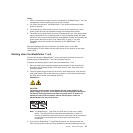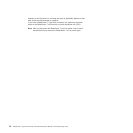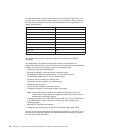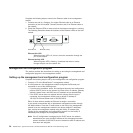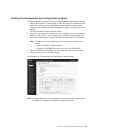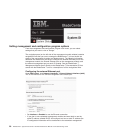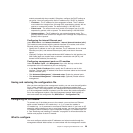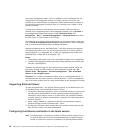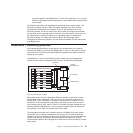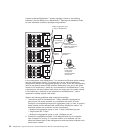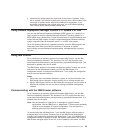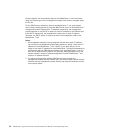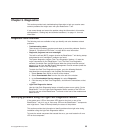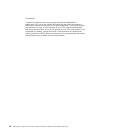
module automatically when needed). Otherwise, configure the DHCP setting as
you prefer. You must configure the static IP address only if DHCP is disabled.
– IP address - The IP address for the management module. The IP address
must contain four integers from 0 through 255, separated by periods, with no
spaces or consecutive periods. The default setting is 192.168.70.125.
– Subnet mask - The subnet mask must contain four integers from 0 to 255,
separated by periods, with no spaces. The default setting is 255.255.255.0
– Gateway address - The IP address for your network gateway router. The
gateway address must contain four integers from 0 through 255, separated by
periods, with no spaces.
Configuring the internal Ethernet port
Under MM Control, click Network Interfaces ” Internal Network Interface (eth1).
This interface communicates with the network-interface I/O modules, such as the
Ethernet switch module or the Fibre Channel switch module.
v Specify the IP address to use for this interface. The IP addresses for the internal
Ethernet port (eth1) and external Ethernet port (eth0) must be on the same
subnet.
v (Optional) Configure the locally-administered MAC address for this interface; the
other fields (data rate, duplex mode, maximum transmission unit (MTU), and
burned-in MAC address) are read-only.
Configuring management ports on I/O modules
Under I/O Module Tasks, click Management; then, click the bay number that
corresponds to the I/O module that you are configuring.
v In the New Static IP address fields, specify the IP address to use for this
interface. The new static IP address must be on the same subnet as the internal
network interface (eth1).
v Click Advanced Management ” Advanced setup. Enable the external ports.
v Click Advanced Management ” Advanced setup. (Optional) Enable external
management.
Saving and restoring the configuration file
After you have configured the management module, you can save the configuration
file to a drive attached to the system running the management-module Web
interface. Then, if the configuration in the management module becomes damaged
or if the management module is replaced, you can restore the saved configuration
file to the management module. Use the management-module Web interface to
save and restore the configuration file (MM Control ” Configuration File).
Configuring an I/O module
To connect any of the blade servers to the network, you must have an Ethernet
switch module installed in I/O-module bay 1 or 2, or a pass-thru module in
I/O-module bay 1 or 2 connected to an external Ethernet switch. If you have an I/O
expansion option installed on one or more blade servers, you must have compatible
I/O modules (switch modules or other compatible modules) in I/O module bays 3 or
4. See “Removing and installing I/O modules” on page 60 for information about the
location and purpose of each I/O module.
What to configure
You must configure switch-module IP addresses and subnet masks through the
management-module Web interface to communicate with the management module
Chapter 2. Configuring the BladeCenter T unit 29



